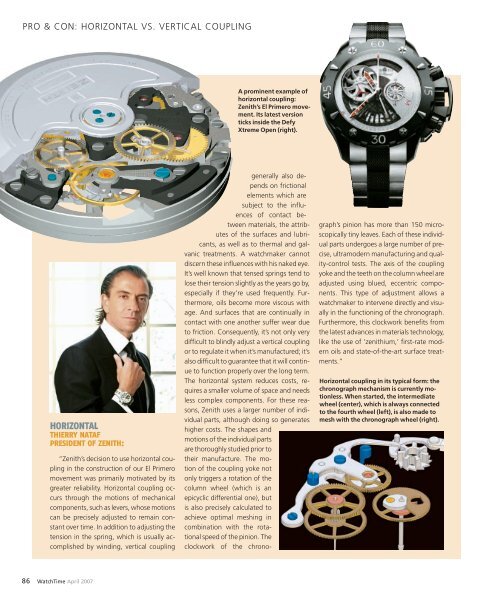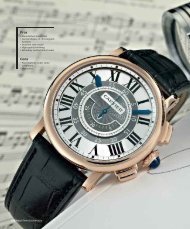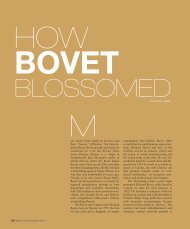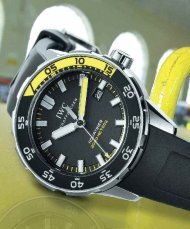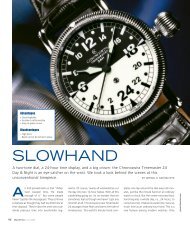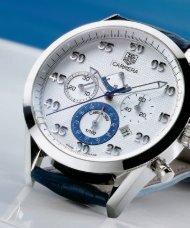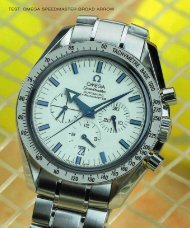pro & con: horizontal vs. vertical coupling - WatchTime
pro & con: horizontal vs. vertical coupling - WatchTime
pro & con: horizontal vs. vertical coupling - WatchTime
You also want an ePaper? Increase the reach of your titles
YUMPU automatically turns print PDFs into web optimized ePapers that Google loves.
PRO & CON: HORIZONTAL VS. VERTICAL COUPLINGA <strong>pro</strong>minent example of<strong>horizontal</strong> <strong>coupling</strong>:Zenith’s El Primero movement.Its latest versionticks inside the DefyXtreme Open (right).HORIZONTALTHIERRY NATAFPRESIDENT OF ZENITH:“Zenith’s decision to use <strong>horizontal</strong> <strong>coupling</strong>in the <strong>con</strong>struction of our El Primeromovement was primarily motivated by itsgreater reliability. Horizontal <strong>coupling</strong> occursthrough the motions of mechanicalcomponents, such as levers, whose motionscan be precisely adjusted to remain <strong>con</strong>stantover time. In addition to adjusting thetension in the spring, which is usually accomplishedby winding, <strong>vertical</strong> <strong>coupling</strong>generally also dependson frictionalelements which aresubject to the influencesof <strong>con</strong>tact betweenmaterials, the attributesof the surfaces and lubricants,as well as to thermal and galvanictreatments. A watchmaker cannotdiscern these influences with his naked eye.It’s well known that tensed springs tend tolose their tension slightly as the years go by,especially if they’re used frequently. Furthermore,oils become more viscous withage. And surfaces that are <strong>con</strong>tinually in<strong>con</strong>tact with one another suffer wear dueto friction. Consequently, it’s not only verydifficult to blindly adjust a <strong>vertical</strong> <strong>coupling</strong>or to regulate it when it’s manufactured; it’salso difficult to guarantee that it will <strong>con</strong>tinueto function <strong>pro</strong>perly over the long term.The <strong>horizontal</strong> system reduces costs, requiresa smaller volume of space and needsless complex components. For these reasons,Zenith uses a larger number of individualparts, although doing so generateshigher costs. The shapes andmotions of the individual partsare thoroughly studied prior totheir manufacture. The motionof the <strong>coupling</strong> yoke notonly triggers a rotation of thecolumn wheel (which is anepicyclic differential one), butis also precisely calculated toachieve optimal meshing incombination with the rotationalspeed of the pinion. Theclockwork of the chronograph’spinion has more than 150 microscopicallytiny leaves. Each of these individualparts undergoes a large number of precise,ultramodern manufacturing and quality-<strong>con</strong>troltests. The axis of the <strong>coupling</strong>yoke and the teeth on the column wheel areadjusted using blued, eccentric components.This type of adjustment allows awatchmaker to intervene directly and visuallyin the functioning of the chronograph.Furthermore, this clockwork benefits fromthe latest advances in materials technology,like the use of ‘zenithium,’ first-rate modernoils and state-of-the-art surface treatments.”Horizontal <strong>coupling</strong> in its typical form: thechronograph mechanism is currently motionless.When started, the intermediatewheel (center), which is always <strong>con</strong>nectedto the fourth wheel (left), is also made tomesh with the chronograph wheel (right).86 <strong>WatchTime</strong> April 2007


